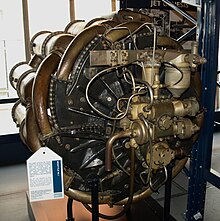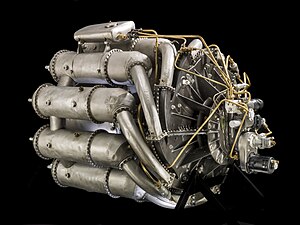| W.1 | |
|---|---|

| |
| The Whittle W.1X at the National Air and Space Museum | |
| Type | Turbojet |
| Manufacturer | Power Jets |
| First run | 14 December 1940 |
| Major applications | Gloster E.28/39 |
| Developed into | General Electric I-A |
The Power Jets W.1 (sometimes called the Whittle W.1 [1]) was a British turbojet engine designed by Frank Whittle and Power Jets. The W.1 was built under contract by British Thomson-Houston (BTH) in the early 1940s. It is notable for being the first British jet engine to fly, as the "Whittle Supercharger Type W1", [2] powering the Gloster E.28/39 on its maiden flight at RAF Cranwell on 15 May 1941. [3] The W.1 was superseded by the Power Jets W.2.
Design and development
After a period of indifference, in June 1939 a demonstration of the Power Jets WU was made before a delegation of the Air Ministry, notably Dr David Pye, Director of Scientific Research. The demonstration was so successful that the Ministry quickly arranged to buy the engine to give Power Jets working capital, lending it back to them for testing.

At the same time, a contract was placed for a "flight engine", the W.1. [4] Unlike the Whittle WU, that began bench testing in 1937, the W.1 was a symmetrical engine designed to facilitate, after development, installation in an aircraft. The W.1 used a double-sided centrifugal compressor of Hiduminium RR.59 alloy, [5] reverse-flow 'Lubbock' combustion chambers and a water-cooled axial-flow turbine section using 72 blades with 'fir-tree' root fixings; the turbine was later modified to use air-cooling. The turbine blades were of Firth-Vickers Rex 78, a stainless steel developed under Dr. W. H. Hatfield. Design rating was 860 pounds-force (3.8 kN) at 16,500 rpm, increased to 17,750 rpm above 4,000 feet. With the W.1 aircraft manoeuvring would subsequently be limited (by compressor-casing stress) to 2 g. Maximum jetpipe temperature was 597 °C.
As development of the new design dragged on, it was decided to build a test unit "early engine" using any components that were deemed unairworthy along with test items. This was assembled to become the one-off W.1X. This officially unairworthy unit powered the Gloster E.28/39 on a short 'hop' during taxiing trials in April 1941, with flight trials taking place a month later with a definitive W.1 engine. In February 1942, the E.28 was tested with the W.1A engine, reaching a speed of 430 miles per hour (690 km/h) at 15,000 feet (4,600 m). [6] [7] For comparison, the Spitfire Mk. V in service at the time had a maximum speed of 374 miles per hour (602 km/h) and the Mk. IX, not yet introduced, mounting an experimental engine reached 403 miles per hour (649 km/h) at high altitude. [8] This purely experimental aircraft and the very first flyable engine outperformed one of the most advanced high-performance aircraft in the world.
After a visit to England in 1941, General Henry H. Arnold arranged for the W.1X to be flown to the U.S in October 1941, along with drawings for the more powerful W.2B engine, together with a team from Power Jets. The former became the prototype of first the General Electric I-A and then the General Electric I-16, and by April 1943 the latter had been developed to produce 1,650 pounds thrust (750 kgf). [9]
In 1941, experiments with boosting the W.1's thrust by introducing a liquid coolant were initiated, the first fluid tried being liquid ammonia which proved too effective, resulting in the engine overspeeding and pushing the thrust and rpm indicators off the scales, before later trials changed to using water, and water-methanol. A system to trial the technique in the E.28/39 was devised but never fitted. [10]
Variants
- W.1(T)
- Built from spares for bench-development only. [11]
- W.1(3)
- Modified W.1.
- W.1X
- Early W.1 built from non-airworthy parts and intended for ground use only (aircraft taxi tests). Later sent to the US in October 1941, becoming the first jet engine to run in North America.
- W.1A
- Based on W.1, 1,450 lbf (6.45KN) air-cooled turbine disc and incorporating features intended for W.2. Used for second series of test flights of E.29/39 W4041/G beginning on 16 February 1942, and fitted with fuel barostat. Later featured modified oil 'ring main' system to prevent oil freezing at altitude. [12]
- WR.1
- Experimental low-pressure design built by Rolls-Royce under contract to Power Jets. [13]
Applications
Engines on display
The Gloster E.28/39 and the Power Jets W.1 engine that powered it are on public display at the Science Museum, London.
The W.1A is kept at the RAF College Cranwell, and the W.1X at the Smithsonian Institution, Washington DC. [13]
Specifications (W.1 early development engine)

Data from Jane's [14]
General characteristics
- Type: centrifugal flow turbojet
- Length:
- Diameter:
- Dry weight: 700 lb (320 kg)
Components
- Compressor: single-stage double-sided centrifugal flow
- Combustors: 10 reverse-flow
- Turbine: single stage axial flow
- Fuel type: kerosene
Performance
- Maximum thrust: 850 lbf (3.8 kN) at 16,500 rpm
- Air mass flow: 20.6 lb/s (9.3 kg/s)
- Fuel consumption: 1,170 lb/h (531 kg/h)
- Specific fuel consumption: 1.376 lb/(lbf⋅h) (39.0 g/(kN⋅s))
- Thrust-to-weight ratio: 1.214
Specifications (W.1 later development engine)
Data from Jane's [14]
General characteristics
- Type: centrifugal flow turbojet
- Length:
- Diameter:
- Dry weight: 700 lb (320 kg)
Components
- Compressor: single-stage double-sided centrifugal flow
- Combustors: 10 reverse-flow can
- Turbine: single stage axial flow
- Fuel type: kerosene
Performance
- Maximum thrust: ~1,032 lbf (4.59 kN)
- Overall pressure ratio: ~3.8:1
- Air mass flow: ~25.4 lb/s (9.3 kg/s)
- Turbine inlet temperature: ~1,430 °F (780 °C)
- Fuel consumption: ~1401 lb/h (~636 kg/h)
- Specific fuel consumption: ~1.358 lb/(lbf⋅h) (38.5 g/(kN⋅s))
- Thrust-to-weight ratio: ~1.474
Gallery
- The engine from different angles
See also
Related development
Comparable engines
Related lists
References
Notes
- ^ Jane's 1989, p. 267.
- ^ "Pioneer Jet". Flight. 27 May 1955. p. 726. Archived from the original on 8 July 2017.
- ^ Gunston 1989, p. 112.
- ^ "Power Jets: A brief biography". FrankWhittle.co.uk. Archived from the original on 4 October 2011. Retrieved 23 April 2011.
- ^ Whittle, F. (1945). "The early history of the Whittle jet propulsion gas turbine" (PDF). Institution of Mechanical Engineers.
- ^ Smith 1946, p. 87.
- ^ Golley, John (1987). Whittle: The True Story. Shrewsbury: Airlife Publishing Ltd. pp. 166–171, 188. ISBN 0906393825.
- ^ Spitfire HF. Mk. IX BS.310 (Merlin 70) (Technical report). Aircraft and Armament Experimental Establishment, Boscombe Down. 9 April 1944.
- ^ Smith 1946, p. 109.
- ^ Whittle, F. (14 August 1947). "Thrust-Boosting of Jet Engines: Some Sensational British Results with Ammonia". Flight. p. 177. Archived from the original on 30 December 2018.
- ^ Whittle, F. (11 October 1945). "Early History of the Whittle Jet Propulsion Gas Turbine". Flight. p. 401. Archived from the original on 21 October 2012.
- ^ Blackburn, Robert J. (27 October 1949). "No Airscrew Necessary..." Flight. p. 556. Archived from the original on 1 December 2017.
- ^ a b "The Secret Years". Flight. 11 May 1951. p. 552. Archived from the original on 29 October 2013.
- ^ a b Jane's 1989, p. 266.
Bibliography
- Jane's Fighting Aircraft of World War II. London: Studio Editions Ltd. 1989. ISBN 0-517-67964-7.
- Gunston, Bill (1989). World Encyclopedia of Aero Engines. Cambridge: Patrick Stephens Ltd. ISBN 1-85260-163-9.
- Kay, Anthony L. (2007). Turbojet History and Development 1930-1960. Vol. 1 (1st ed.). Ramsbury: The Crowood Press. ISBN 978-1-86126-912-6.
- Smith, Geoffrey G. (1946). Gas Turbines and Jet Propulsion for Aircraft. London: Flight Publishing Co.
- Stroud, Nick (2017). "Fire in the Belly". The Aviation Historian (20): 90–97. ISSN 2051-1930.




